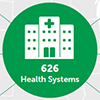National Healthcare Quality and Disparities Report
Latest available findings on quality of and access to health care
Data & Analytics
- Data Infographics
- Data Visualizations
- Data Tools
- Data Innovations
- All-Payer Claims Database
- Consumer Assessment of Healthcare Providers and Systems (CAHPS®) Program
- Healthcare Cost and Utilization Project (HCUP)
- Medical Expenditure Panel Survey (MEPS)
- National Healthcare Quality and Disparities Report Data Tools
- Network of Patient Safety Databases
- AHRQ Quality Indicator Tools for Data Analytics
- Surveys on Patient Safety Culture
- United States Health Information Knowledgebase (USHIK)
- Data Sources Available from AHRQ
Data Resources
Filter by Topic
- Access to Care (4)
- Adverse Events (1)
- Ambulatory (2)
- By Payer (2)
- By State (3)
- Children (3)
- Children (1)
- Children/Adolescents (1)
- Clinicians (1)
- Community Pharmacies (1)
- (-) Costs (2)
- Costs & Charges (1)
- Coverage (4)
- Data (3)
- Discharges by State (1)
- Disparities (2)
- Elderly (1)
- Element Definitions, Values & Information Models (1)
- Emergency Departments (4)
- Employer (1)
- Estimates (State & Metro) (1)
- Expenditures & Projections (3)
- Health (5)
- (-) Health Care (8)
- Health Conditions (5)
- Health Plans (3)
- Health Systems (1)
- Hospital Characteristics (2)
- Hospitalizations (10)
- Household Spending (1)
- Injuries Seen (1)
- Inpatient Care (1)
- Insurance (9)
- Medicaid (1)
- Medicare (1)
- Men (1)
- Mental Health (3)
- Mental Health and Substance Abuse Disorders (2)
- Obesity (1)
- Opioids (1)
- Patient Experience (1)
- Payment Sources (1)
- Premiums (1)
- Prescription Drugs (1)
- Preventable (1)
- Private (1)
- Quality (3)
- Readmissions (2)
- Safety Culture (1)
- SCHIP (1)
- Spending (2)
- State (1)
- Surgery (3)
- Systematic Review (1)
- Systems - Characteristics (1)
- Uninsured (2)
- Use (3)
- Visits (2)
- Women (2)
Data Resources
The Agency for Healthcare Research and Quality (AHRQ) offers practical, research-based tools and other resources to help a variety of health care organizations, providers and others make care safer in all health care settings.
Results
1-8 of 8 Resources displayed
This inaugural edition of the Compendium—Compendium of U.S. Health Systems, 2016—is composed of 626 U.S. health systems, defined in this analysis to include at least one hospital and at least one group of physicians providing comprehensive care, and who are connected with each other and with the hospital through common ownership or joint management. The Compendium database includes: System identification number (a unique number assigned by AHRQ), name, home office city, and State. Indicators of which data source identified the health system and health system identification numbers in the originating data source. Total counts of system hospitals, physician groups, physicians, primary care physicians, extent to which systems own or manage hospitals in multiple States, total acute care beds, discharges, and residents. Variables identifying the extent to which systems include investor-owned hospitals, serve children, include teaching hospitals, and serve a disproportionately high share of low-income and uninsured individuals.

The Medical Expenditure Panel Survey (MEPS) is a set of large-scale surveys of families and individuals, their medical providers, and employers across the United States. MEPS is the most complete source of data on the cost and use of health care and health insurance coverage.

The MEPS Medical Provider Component (MPC) collects data from a sample of providers (physicians, hospitals, home health agencies, and pharmacies) who provided medical care to MEPS Household Component respondents. The MPC collects data on dates of visits/services, use of medical care services, charges and sources of payments and amounts, and diagnoses and procedure codes for medical visits/encounters.

Because demographic characteristics are collected in the MEPS-Household Component, health care disparities can be examined for any topics within the MEPS Household Component survey.

Projected household expenditure data from the 2002 MEPS Household Component file aligned with the 2002 National Health Expenditure Accounts (NHEA). Projected expenditures are calculated in a two-step process. First, core data from the 2002 NHEA-aligned MEPS file are projected to each end year through 2016 by adjusting MEPS person weights with Census projections for population totals, fertility and mortality over time. Then, the re-weighted NHEA-aligned MEPS expenditures are calibrated annually by type of service and source of payment categories so that growth in the re-weighted NHEA-aligned MEPS expenditures matches growth in the projected NHEA. Users should be aware that these estimates are surrounded by uncertainty from a wide variety of sources.

Health care costs (both charges and payments) are collected for all persons for each medical event they experience in the year, including the amount from each payment source. Charges are the dollar amounts asked ("charge") for a service by a health care provider. This is often different from the actual payments made to providers. Expenditure estimates are based on payments, not charges. More specifically, expenditures in MEPS are comprised of direct payments for care provided during the year, including out-of-pocket payments and payments by private insurance, Medicaid, Medicare, and other sources. In addition to the tables, query tool, and publications below, person-level and event-level data files with health care expenditure variables can be downloaded for analysis.

MEPSnet is a collection of analytical tools that operate on MEPS data in two categories: MEPSnet/Household Component provides easy access to nationally representative statistics of health care use, expenditures, sources of payment, and insurance coverage for the U.S. civilian noninstitutionalized population. MEPSnet/HC allows you to generate statistics using MEPS Household Component public use files. MEPSnet/Insurance Component provides easy access to national and state level statistics and trends about health insurance offered by private establishments and state and local governments. MEPSnet/IC guides you step-by-step in locating statistics of interest across all available years using data from the MEPS Insurance Component Summary Data Tables.

This report measures trends in effectiveness of care, patient safety, timeliness of care, patient centeredness, and access to care. The report presents, in chart form, the latest available findings on quality of and access to health care.



